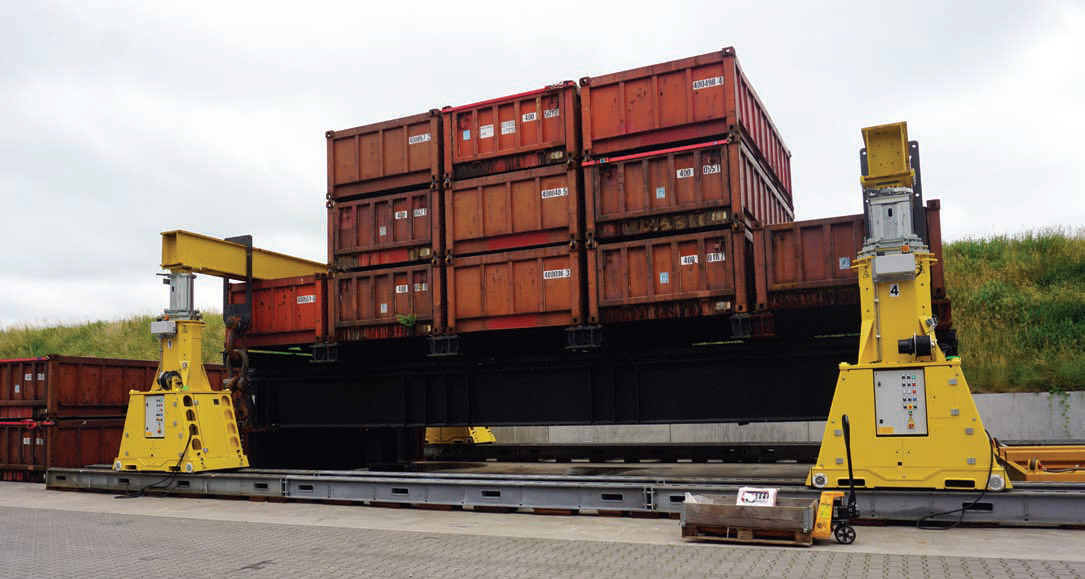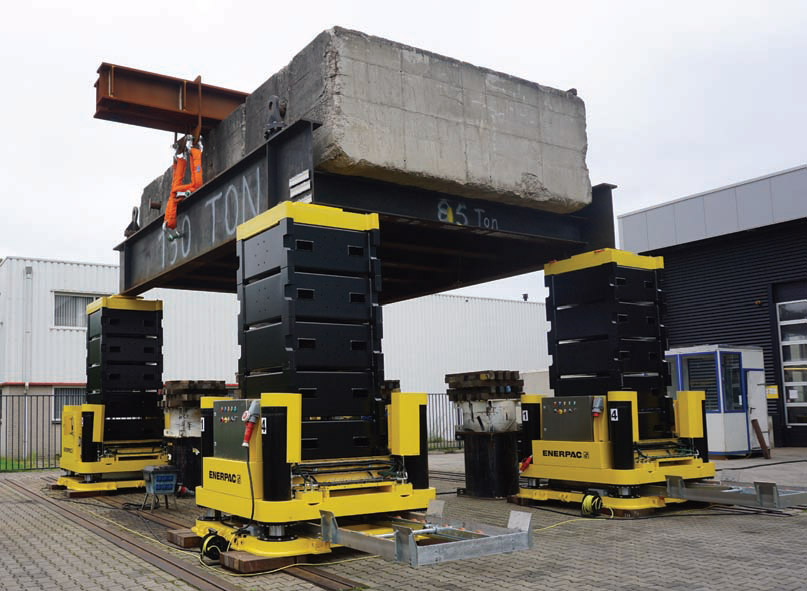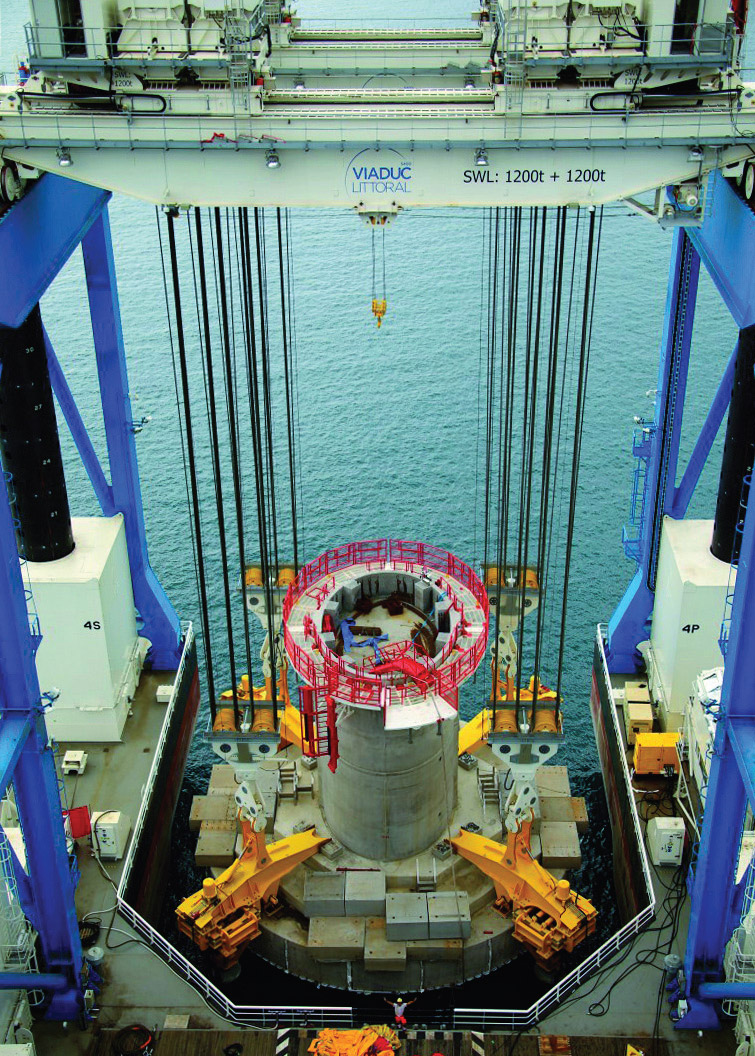Synchronised lifting
4 October 2016Paola De Pascali visited Enerpac Integrated Solutions in Hengelo, the Netherlands. The manufacturer of hydraulic tools and positioning systems offers solutions ranging from small gantries up to the giant floating gantry being used to build a new highway around Reunion Island.
Enerpac Integrated Solutions in Hengelo is a business unit of US-based Enerpac, itself a division of Actuant Corporation.
Enerpac has been a provider of high pressure hydraulic tools for nearly 100 years, and has more than 30 years’ experience in delivering hydraulic solutions for the controlled movement and positioning of heavy loads.
The Hengelo manufacturing facility was acquired by Actuant Corporation, when they purchased the shares of Hydrospex, a Dutch company specialised in heavy lifting in 2010.
Jeroen Naalden, global director of Enerpac Integrated Solutions in Hengelo says: “Our history goes back to 1910 when American Grinder Company produced water pumps for Ford’s legendary ‘Model T’ motor car,” he says. “The company later purchased a small hydraulics company in Los Angeles, California, which triggered its focus on hydraulic technology. Its reputation as a technology leader began in the 1920s when the first hydraulic cylinders and pumps were introduced, under the brand Blackhawk, which later became Enerpac.
“Actuant business operations are divided into three segments: the engineered solutions segment; energy sectors completely focused on oil and gas; and the industrial segment.
“Enerpac Integrated Solutions is part of the last segment, serving several industries in many sectors such as infrastructure, power generation, oil and gas, and mining.”
The Hengelo facility provides design, manufacturing, including machining and welding, as well as testing capabilities. Standard products such as hydraulic telescopic gantries, strand jacks, self-propelled modular transporters and skidding systems as well as bespoke projects are fully assembled and tested in-house.
“As Enerpac Integrated Solutions (EIS), we provide high-force systems solutions to meet customers’ requirements for safe precise control of movements and positioning in addition to lifting, lowering, pushing and pulling,” Naalden says.
Business relations
Naalden describes three different types of customers, who can be distinguished in the market. He says: “We globally supply special solutions to large heavy lifting and rigging companies such as Mammoet, Burkhalter, Bigge, who usually require tailor-made and unique products.
“However, we sell standard equipment such as gantries, trailers and strand jacks to smaller rigging companies that do a lot of press escalations and machine movements.
“We also work with large engineering contractors, like Hyundai, BP, Vinci and Siemens, on projects for power generation, oil and gas as well as nuclear power industries. On these engineering projects, we are able to work alongside the main contractor to provide highly bespoke, projectspecific systems.”
Products
Naalden explains that the EIS product line includes hydraulic telescopic gantries, strand jacks, skidding systems, synchronous lifting systems and self-propelled modular transporter and custom solutions.
“We offer three series of hydraulic telescopic gantry systems: the cost effective Super Lift (SL) series for entry level control and capacity; the Super Boom Lift (SBL) series up to 1,100t capacity and the Mega Boom Lift (MBL) series, which can deliver the stability to utilize a twoleg configuration and achieve lifting heights over 12,000 mm,” he says.
Enerpac hydraulic gantries have been designed with a number of unique features to ensure optimum stability and safety: self-contained hydraulics and electrics, selfpropelled wheels or tank rollers, and the IntelliLift wireless control system.
For ease of transportation, the SBL1100 and SBL900 hydraulic gantries feature a foldable boom, making them the only heavy duty gantry capable of being shipped in a 20ft container.
The strand jack lifting technique was developed from the concrete post tensioning principle. A strand jack can be considered as a linear winch, where a bundle of steel cables or strands are guided through a hydraulic cylinder. Above and below the cylinder are anchor systems with wedges that grip the strand bundle simultaneously. The motion of the cylinders is driven by hydraulic power packs, which can be electric or diesel-powered. Enerpac’s Smart Cylinder Control (SCC) software program synchronizes the motion of the strand jacks and adjusts the motion to the loads per lifting point.
Enerpac strand jacks are available with two types of strand: a standard strand of 15.7mm diameter and an 18mm version.
The 15.7mm strand can work with a dynamic load of 110kN. The 18mm strand can work with a dynamic load of 155kN. Enerpac strand jack systems are available from 30–1,000t capacity.
The HSK skidding system is comprised of a series of skid shoes powered by hydraulic pushpull cylinders, travelling over a pre-constructed track. A series of special PTFE-coated blocks are placed on the skid tracks to reduce friction. The skid shoes are connected by hoses to a hydraulic diesel-driven power pack.
Enerpac Skidding Systems are available in two versions: the HSK1250 with a capacity of 1,250kN per skid unit and the HSK2500 with a capacity of 2,500kN per skid unit.
To calculate the minimum required capacity per shoe, the entire load has to be able to rest safely on two of the four shoes. To skid a load of 500t, the required skidding system is HSK2500.
The Enerpac self-propelled modular transporter (SPMT) features a minimised height and slim design, which enables it to operate easily in confined spaces. Each wheel unit has a steering as well as a lifting cylinder at its disposal.
Enerpac recently announced the new 600 Series SPMT designed for in-plant operation. The SPMT’s slim height and compact frame make it easy to lift, manoeuvre and lower a load in a confined space. Each wheel has an individual drive motor, steering actuator and lifting cylinder.
The modular design enables multiple trailer configurations, increasing the total capacity of the system. A single trailer can transport up to 60t. The equalized suspension automatically spreads the weight of a load across each of the connected trailers and wheels.
There are two standard SPMT models. The SPMT600-100 has a rack and pinion steering system capable of +/-50° steering and a maximum configuration of 4 x 2 units. The versatile SPMT600-360 has a slew drive steering system capable of +/-179° steering and maximum configuration of 6 x 2 units.
The SPMT is controlled by IntelliDrive, a wireless control system that allows the entire system to be operated by one person. One of the main features of the system is that it can be containerised.
Enerpac’s family of EVO synchronous lifting systems provides precision control suitable for most lifting and lowering applications.
To achieve high-precision movement of heavy objects it is necessary to control and synchronize the movements of multiple lifting points.
The PLC control uses feedback from multiple sensors to control the lifting, lowering and positioning of any large, heavy or complex structure, regardless of weight distribution.
The Enerpac EVO-Series offers the required level of force and control for most applications.
The EVO system can also deliver additional features including a greater number of lift points, centre of gravity and tilting, weighing capabilities.
“This year we also introduced the Sync Hoist System (SHS) to provide high precision high load manoeuvring, vertically and horizontally, using one crane,” Naalden says.
Using a single crane reduces risk and cost and vastly improves operating speed and worker safety. A single crane also minimises the risk of damage from oscillations of wire rope due to sudden crane starts and stops.
The synchronous hoist system can be used for pre-programmed positioning, tilting, aligning and high precision horizontal and vertical load positioning.
Naalden says: “We have recently developed the JS-Series jack-up system, starting with the smallest models JS125 and JS250 up to the biggest JS500 and JS750. The numbers are based on the capacity per leg.”
The JS-Series Jack-Up System uses four hydraulically operated jack-up units positioned at each corner of the lifting system with steel connection bracing. The load is lifted in increments, as steel cubes called “barrels” are slid into each jack-up unit, and stacked to form ‘lifting towers’. Each unit’s lifting and lowering operations occur simultaneously, the system’s central computer control synchronises each jack-up unit and maintains the balance of the load. Once lifted to the desired height, the load is supported mechanically by the stacked barrels and a new steel extension leg section is inserted into each crane leg. The precision control offered by the JS-Series jack-up hydraulic system allows accurate positioning of the legs and permits work on the load while it is mechanically supported.
Naalden says, “Beyond these products, we also combine hydraulics, steel fabrication and electronic control with engineering and application knowledge, to design and manufacture solutions that can ensure safety and efficiency.”
Among the custom solutions, there is a strand jack gantry, which is a steel structure to facilitate lifting, rotating and skidding back, forth and sideways of heavy loads.
This solution combines three major components: steel construction, strand jacks for vertical lifting, and skidding system for horizontal movement.
Development and technology EIS director of projects and engineering, Mart Hinnen says: “Over the years we’ve developed several new technologies such as the remote controlled PLC systems, and products like hydraulic winches, incorporating them into our system offerings.
“Our biggest focus is to develop new products and concepts based on proven technologies that we know very well.
“The jack-up system development is from a technology perspective perhaps not very complicated, but we’ve seen that customers are very interested in the concept of mechanical stacking of barrels lifting from the bottom instead of from the top.
“Our expertise in combining structural engineering with hydraulics and intelligent controls provides us with a great potential to develop new applications.
Throughout the years we’ve learned a lot in this matter and, as a result, the systems we develop are getting more and more cutting edge.”
Hinnen explains the focus is not just on adding new products, but also on improving existing products and expanding the portfolio of standard products, for example by adding new hydraulic gantry types to the current hydraulic gantry offering.
He adds: “Besides having this engineering knowledge, we also have a manufacturing organization that is situated close to the design engineers. Prototypes can be developed and manufactured quickly and issues can also be effectively resolved by using the total group of specialists.
“The biggest asset we have is, therefore, our people. The combination of design engineers, senior assembly operators and service engineers provides Enerpac with the capability to not only design a solution for a customer, but also to manufacture, assemble, install and commission this on-site within a very short time frame. Customers value this one-stop shop, and the relation we have with existing customers is long-lasting.”
Synchronised lifting Synchronised lifting is a key differentiator for Enerpac Integrated Solutions.
“It’s a natural development of our expertise in hydraulics and control systems, enabling us to offer a range of multi-point lifting solutions unmatched in the industry,” Naalden says.
Enerpac’s multi-point lifting systems range from a simple mechanically controlled handoperated portable lifting cylinder and SFP-Series Split Flow Pumps with up to six flow outlets, to computer controlled EVO-Series synchronous lifting systems, JS-Series Jack-ups and SHS-Series SyncHoist.
Key to Enerpac’s synchronised lifting strategy is the ease of use and safety aspects of the wireless control interface. Accurate wireless control of lifting is the trademark of Enerpac synchronised lift, jack-up and gantry systems. Using the Intellilift portable wireless control unit, a single operator can control and oversee the entire lifting job at a safe distance.
“The application flexibility within Enerpac’s multi-point lifting systems range is enormous. They offer greater accuracy, ease of control of the lift and, more importantly, increased safety compared with attempting synchronised lifts using standalone products,” notes Naalden.
Projects
One of the biggest jobs of the last two years was the development of world’s largest offshore gantry crane for the coastal highway on Reunion Island (Cranes Today, June 2016, p6). The project is conducted by French consortium Bouygues Travaux Publics, VINCI Construction Grands Projets, Dodin Campenon Bernard and Demathieu Bard Construction.
Enerpac had fabricated and tested the overhead travel crane (OHTC) at Hengelo which was then shipped to Poland and positioned on top of the Zourite jack-up barge and shipped to Reunion Island.
Naalden says: “They are ready for the first of 300 lifting jobs to put foundations for a 5,400m bridge over the sea around the island.”
The OHTC comprises two pairs of lifting beams, with an overall width of 30m, and a lifting capacity of 4,800t for lifting, moving and lowering the concrete blocks for the offshore highway.
Lifting and lowering is accomplished with a reeved winch system, based on eight grooved drum winches. Longitudinal travelling of the gantry uses a trolley arrangement comprising two trolleys per lifting beam. Each trolley is propelled with hydraulic drive motors and planetary gearboxes.
The wheels run on two parallel rails bolted onto the barge’s runway beams. Side shifting of the gantry hoists in a continuous movement is achieved using long stroke cylinders.
OHTC testing has been conducted on one of the pairs of beams and included lifting 1,100t blocks, synchronized lifting of the block with a hook from each beam, and checking the crane’s positioning, lifting and lowering accuracy to 1mm.
Enerpac has also developed the offshore highway’s pier installation handling and adjustment device. It will be used to lift and lower the pier bases onto a level gravel surface on the seabed, and for adjustments to the base vertically and horizontally.
Enerpac Integrated Solutions has also designed and fabricated a 170mt Vertical Cask Transporter (VCT) for Holtec International, a diversified energy technology. The transporter combines the lifting capability of a hydraulic gantry with the flexibility of a self-propelled modular transporter (SPMT) to provide safe handling of the casks.
The VCT can provide a system for safely handling and transporting casks at a spent nuclear fuel storage facility.
The wheeled cask transporter’s modular assembly design includes a number of key functional and safety features such as an innovative cab design allowing the VCT operator to face the direction of travel.
“The Vertical Cask Transporter is the ideal solution for moving spent nuclear fuel storage casks that need to be lifted and manoeuvred on-site,” says Hinnen, “It is especially suited to handling casks where space restrictions rule out the use of a crane.”
Enerpac has also extended the height of a 2,000t jack-up system from 20m to 36m for Burkhalter, a leading engineered heavy lift and transport company.
The near doubling in height will produce the world’s tallest jack-up system, allowing Burkhalter to handle more civil engineering and industrial multipoint lifts.
Enerpac’s jack-up system is a custom-developed multipoint lifting system, which includes four 2,000mt jack-up towers positioned under each corner of a load. The lifting frame of each jack-up tower contains four hydraulic cylinders, which lift and stack steel boxes measuring 1m in height. A load is lifted in increments as boxes are inserted via an automated system; forming ‘lifting towers’.
“We had considered using strand jacks for a bridge demolition project, however, the barge-mounted Enerpac jack-up system will be a safer, more efficient, synchronised lift of the bridge off its foundations,” said David James, project manager at Burkhalter. “Working with the Enerpac team, we developed the concept of a taller jack-up system that retained the lift capacity and versatility of multipoint synchronised lifting for loads up to 2,000t.”
Enerpac also supplies Beluga Projects Logistic, a leading expert in oversized and heavy cargo logistics in Russia and CIS. The SBL 1100 hydraulic gantry system is used for loading, longitudinal and lateral movement of super oversized cargoes. Since 2013 ten lifts have been accomplished.
Market
Naalden explains how the market is evolving for big hydraulic systems to do heavy lifting and positioning jobs. He says: “There is a trend in the infrastructure sector to work mainly with pre-fabricated elements, allowing a fast construction for bridges and for all the heavy elements. That means, an increase in the demand for heavy lifting and moving structures.
“There is also a strong request in the power generation sector, such as in the nuclear industry to do maintenance for nuclear waste or for other nuclear tools, which need to face lifting challenges. Companies are currently paying a lot of money to do it with cranes and they can’t be used in confined spaces most of the time. Conversely, we can offer cheaper alternative solutions for any type of application.
“With regard to mining and oil sectors, the market is quiet at the moment, but we are able to fulfil that demand with the power generation and the infrastructure sector. For example, in North Africa there is a good demand for heavy lifting equipment because these countries want to invest in power plants. Even though they don’t have so much money to invest on that, they have the resources such as fuel and gas. Africa also provides food to China, which in turn has started investing in these countries.
“Another big driver of demand is in the US where existing infrastructure needs to be renewed, such as numerous bridges dated back 60s. We also have good sales in South East Asia, thanks to on-going population growth and economic development. Over the last two years, 30% of our turnover is related to Asia and Africa.”
Naalden adds: “I see a bright future, we are doing big steps to become a large supplier of heavy lifting equipment globally. Brexit will have a very small impact, as only 2% of Enerpac Integrated Solutions’ turnover is related to the UK.”




